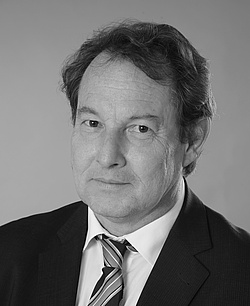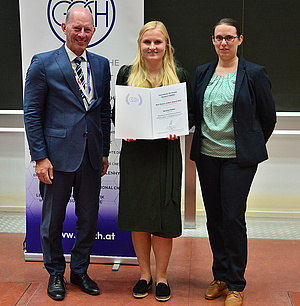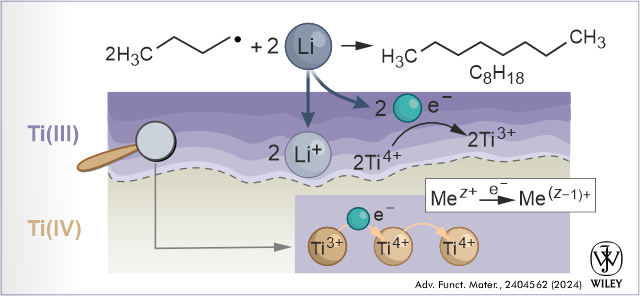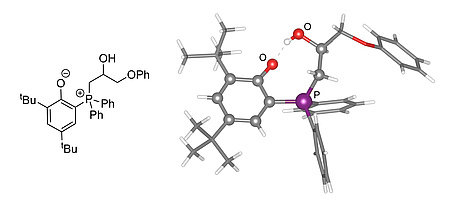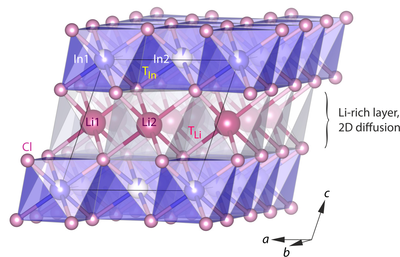
 Morphology aspects in understanding ionic conduction in thiophosphates
Morphology aspects in understanding ionic conduction in thiophosphates
Amorphous vs. crystalline: The (exact) morphology may strongly influence overall ion dynamics in many cases. For Li3PS4, if prepared via a solvent-assisted approach, the change of ionic conductivity between a fully X-ray amorphous sample and a crystalline one obtained after annealing was much less influenced by this principle. See our latest study in Dalton Trans.: Morphology-dependent Li+ ion dynamics in X-ray amorphous and crystalline Li3PS4 prepared by solvent-assisted synthesis, J. Spychala, C. Mandl, K. Hogrefe, H. M. R. Wilkening, B. Gadermaier, Dalton Trans. (2024) in press.
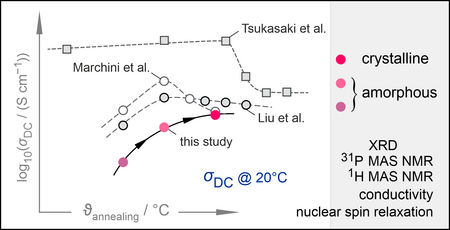
 ICTM mourns the death of Prof. Wolfgang Kern
ICTM mourns the death of Prof. Wolfgang Kern
Wolfgang Kern (born 1963) passed away on Sun. September 29, 2024. Wolfgang Kern was a dedicated researcher and educator, first at the TU Graz and then, since 2007, at the University of Leoben. Many of us knew Wolfgang Kern as a passionate and diligent researcher and science manager with the goal of solving real-world problems. Those of us who were fortunate enough to know him better have lost a warm-hearted, larky friend. Our hearts go out to his wife and family.
 Best Review Award
Best Review Award
During the Austrian Chemistry Days, Karin Ratzenböck and Susanne Fischer received the Best Review Article Award 2023 of the Monatshefte für Chemie (Springer) for their paper "Poly(ether)s derived from oxa-Michael polymerization - A comprehensive review" (DOI: 10.1007/s00706-023-03049-4).
Many congratulations!
 ICTM organized this year's YPRA meeting
ICTM organized this year's YPRA meeting
The Young Polymer Researchers Austria (YPRA) meeting aimed to bring together undergraduate and graduate students as well as early career postdoctoral researchers in the field of polymer science from Austria and neighboring countries. The meeting provided a forum for the presentation of research in the form of oral and poster presentations, with ample time for networking and some input from senior researchers, and was held in Weiz, Styria, from September 18-20, 2024. For more information, please visit the YPRA website.
 Effective conductivities in composite cathode materials
Effective conductivities in composite cathode materials
Post-synthesis ball milling impacts the structure and performance of the solid electrolyte Li5.5PS4.5Cl1.5. Shorter milling times optimize particle size and ion transport, while longer processing reduces ionic conductivity. Optimizing this process is crucial for high-performance solid-state batteries. NMR helped characterize local structures and ion dynamics. See the paper of the Zeier group (Münster) in Adv. Energy Mater.
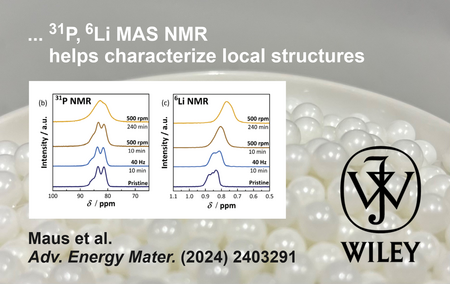
 2D EXSY NMR and binary Li electrolytes
2D EXSY NMR and binary Li electrolytes
1D and 2D Li(6,7) exchange MAS NMR revealed slow Li exchange between the lithium sulfide and lithium iodide environments in the mechanically prepared nanocomposites. Though detectable, it is by far not dictating overall conductivity here. Link to Anna's paper in Small Science.
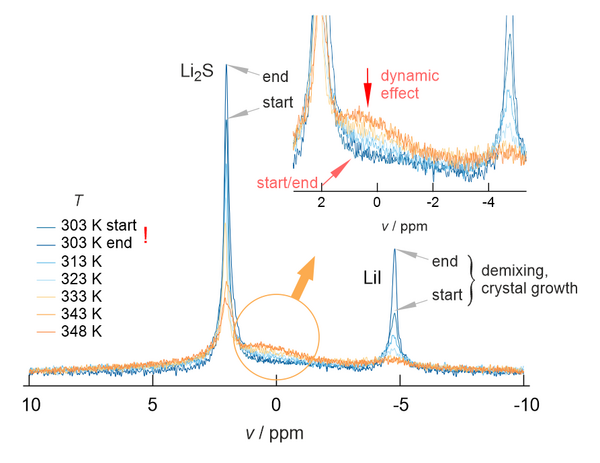
 NMR at temperatures reaching the cryogenic region
NMR at temperatures reaching the cryogenic region
See our latest NMR measurements carried out at temperatures as low as 9 K (cryogenic range). Such temperatures are needed to reveal the full set of details on Li ion hopping and spin-relaxation in argyrodite-type solid electrolytes. Great collaboration with W. Zeier's group from Münster University, Germany. Link to the Chem. Mater. paper.
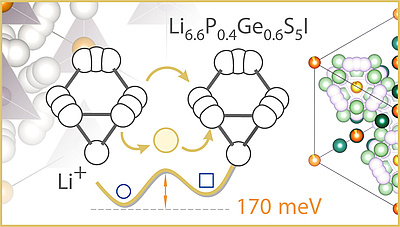
 Zero Emissions Award for Thomas Rath
Zero Emissions Award for Thomas Rath
The Zero Emissions Award, Austria's largest prize for climate-relevant fundamental research, recognizes projects that address knowledge gaps in the energy transition or pursue promising new approaches. Funded by the alpha+ Foundation of the FWF, the award is given annually to two outstanding research projects that make a significant contribution to climate research.
Thomas Rath was honored for his research on improving organic solar cells and will receive a grant of 460,000 EUR. His project focuses on researching the properties of halogenated absorber materials in various solar cell architectures in order to exploit the full efficiency and stability potential of organic solar cells. Congratulations to Thomas on this prestigious award!
 Li Motions Made Visible
Li Motions Made Visible
Phase Transitions and Ion Transport in Lithium Iron Phosphate by Atomic-Scale Analysis to Elucidate Insertionand Extraction Processes in Li-Ion Batteries: Our new study shows systematical tracking of lithium ions within their respective channels and unveils the phase distribution within individual LFP crystallites not only quantitatively but also at unprecedented atomic-level resolution. Great collaboration between Ilie Hanzu and the team at Felmi, link to the paper in Adv. Energy Mater. (2024).
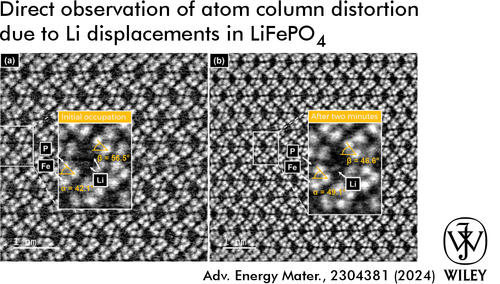
 Mixed Conducting Interfaces in Batteries
Mixed Conducting Interfaces in Batteries
MCI formation in LATP-based solid electrolytes: Read Thomas Scheiber's latest results on mixed ionic-electronic conductivities in phosphates, a topic which in general is rising. Ionic and Electronic Conduction of the Mixed Conducting Interphase in All-Solid-State Batteries: Lithiated Li1.3Al0.3Ti1.7(PO4)3 as a Case Study, T. Scheiber, B. Gadermaier, M. Finsgar, H. M. R. Wilkening, Adv. Funct. Mater., 2404562 (2024).
 Guest lecture by Prof. Egon Pavlica
Guest lecture by Prof. Egon Pavlica
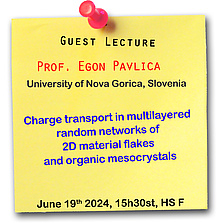 At the invitation of Prof. G. Trimmel, Prof. Egon Pavlica (University of Nova Gorica, Slovenia) will give a talk entitled "Charge transport in multilayered random networks of 2D material flakes and organic mesocrystals" on June 19th.
At the invitation of Prof. G. Trimmel, Prof. Egon Pavlica (University of Nova Gorica, Slovenia) will give a talk entitled "Charge transport in multilayered random networks of 2D material flakes and organic mesocrystals" on June 19th.
Abstract: Solution processable two-dimensional materials have great potential in the application of printed electronic elements. Typically their electrical properties like e.g. charge mobility of this randomly oriented network of flakes is significantly lower than in a single flake of the same material. Our recent success was obtained with randomly oriented Ti3C2 MXene flakes. The results of time-of-flight photoconductivity measurements confirm electron transport with mobilities above 270 cm2/Vs, which is substantially higher than previously reported field-effect mobility, which was below 10 cm2/Vs. Mobility was increasing with electric field - characteristic to disordered materials. The extrapolated zero-field mobility of 38 ± 15 cm2/Vs reaches values measured in single Ti3C2Tx MXene flakes (34 cm2/Vs). We suggest that this is a consequence of precise MXene exfoliation and efficient deposition process. The exfoliation yielded flakes with the largest dimensions on the order of several microns. The deposition of the layers resulted in up to 6-layer-thick film of interconnected randomly oriented flakes. We demonstrate that the transport through such randomly connected percolation network can be characterized as charge transport through crystalline flakes, perturbed by trapping in the localized states, residing at the interfaces between the flakes. The former process results in high charge mobility, the latter results in a low charge carrier mobility. This duality is likely to be responsible for relatively high values of TOFP-measured charge carrier mobility. These results also suggest that charge trapping at the dielectric interface becomes less important when the charge carriers are transported through several pristine MXene layers above and away from the dielectric interface as in our TOFP experiments. This results in overall higher observed charge carrier mobility. On the other side, the charge carrier mobility exhibits positive dependence on the electric field of the Poole-Frenkel type, which is typical for disordered material. This behavior seems to be pertinent to a multilayered network of randomly distributed flakes with an interfacial electronic structure, which does not suppress the charge transport, but it represents a bypass to improved charge carrier transport. Similar behavior is observed in mm-sized mesocrystals of semiconductor polymers.
 Intercepting the Wittig reaction - the formation of zwitterions from diphenylphosphinophenol and oxiranes
Intercepting the Wittig reaction - the formation of zwitterions from diphenylphosphinophenol and oxiranes
By studying the reaction of a diphenylphosphinophenol with oxiranes, we were able to answer the question of why tertiary phosphines are poor initiators for epoxy homopolymerization, but perfect for curing epoxy phenolic resins. The paper describes the formation of phosphonium phenolate zwitterions from the reaction of 2,4-di-tert-butyl-6-(diphenylphosphino)phenol and various oxirane derivatives. Decomposition studies of the zwitterions showed high thermal stability in solution under ambient conditions. In the homopolymerization of oxiranes, triphenylphosphine deactivates via Wittig chemistry to form allyloxy derivatives and triphenylphosphine oxide via the intermediate initial zwitterion. This pathway is blocked by the addition of phenols, as the alkoxide group present in the initial zwitterion is protonated by the phenol, thereby inhibiting oxaphosphetane formation and ultimately the formation of olefins and phosphine oxides.
 2D Ion Conductors
2D Ion Conductors
Back to the (my) roots: nuclear spin relaxation and two-dimensional ionic hopping; the diversity of NMR. Even for powder samples NMR is able to tell us about spatial restrictions to which the ions are subjected in layer-structured materials. See Florian's NMR measurements on Li3InCl6 in Phys. Rev. B (link)
 Klaus Reichmann re-elected as the AuCerS Chairman
Klaus Reichmann re-elected as the AuCerS Chairman
Ao.Univ.Prof. Dr. Klaus Reichmann has been re-elected as the Chairman of the Austrian Ceramic Society (AucerS). AuCerS is the central platform for industrial and academic ceramic research in Austria and is a full member of the European Ceramic Society (ECerS). The society promotes research and development in the field of ceramics, supports students and young scientists, and represents Austrian ceramists in international organizations.
 AuCerS "Young Scientist Award 2024" for Jurij Koruza
AuCerS "Young Scientist Award 2024" for Jurij Koruza
At the 12th Workshop and General Assembly of the Austrian Ceramic Society (AuCerS), Assoc. Prof. Jurij Koruza has received the “AuCerS Young Scientist Award 2024” for his work on ferroelectric and piezoelectric ceramics. The award is given to young researchers in Austria for outstanding contributions to the field of ceramic materials.
 Guest lecture Dr. Andreas Klingler
Guest lecture Dr. Andreas Klingler
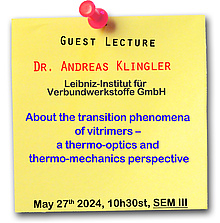 At the invitation of Dr. E. Rossegger, Dr. Andreas Klingler (Leibniz-Institut für Verbundwerkstoffe GmbH) will gave a talk entitled "About the transition phenomena of vitrimers – a thermo-optics and thermo-mechanics perspective" on May 27th.
At the invitation of Dr. E. Rossegger, Dr. Andreas Klingler (Leibniz-Institut für Verbundwerkstoffe GmbH) will gave a talk entitled "About the transition phenomena of vitrimers – a thermo-optics and thermo-mechanics perspective" on May 27th.
Abstract: Vitrimers, repairable and reshapable polymer networks have had quite an impact on the polymer and polymer composite community in recent years, because they combine the often demanded performance and sustainability needs, at least theoretically. The temperature-dependent, macroscopic relaxation behaviour of vitrimers is thereby of special interest, since it allows to reshape, recycle, and even repair a cross-linked polymer on a molecular level. The transition to a molecularly-induced malleability was originally described as a type of second glass transition phenomenon, triggered by temperature and force, and being on the same phenomenological level as a canonical glass transition. Hence, it is obvious to use a susceptibility that strongly couples to glass transitions, such as the thermal volume expansion, to investigate the malleable-to-thermoset transition of vitrimers.
In this talk, first, the vitrimer transition phenomena and the existence of a so called topology freezing transition temperature at the example of a model vitrimer that undergoes transesterification, will be discussed. Using a combined approach of thermo-mechanical analysis and temperature-modulated optical refractometry, it is demonstrated that only the canonical glass transition is ultimately hindering the vitrimer to undergo shape changes or creep. Second, first results on variations of the morphology formation (network structure) will be presented and potential consequences for the malleability will be discussed.
 Disorder in Solids and its Consequences for Ion Dynamics
Disorder in Solids and its Consequences for Ion Dynamics
Disorder in solid electrolytes and its impact on the various parameters controlling lithium-ion dynamics. Li4PS4I turned out to be a another model system to understand the changes in more detail. See Anna's and Jonas' impedance and NMR paper in Chem. Mater. Link to the publication.
 Proton transfer is key for zwitterion formation
Proton transfer is key for zwitterion formation
A recent publication describes the conjugate addition of 2,4-di-tert-butyl-6-(diphenylphosphino)phenol to Michael acceptor molecules, which allows for a facile modular synthesis of stable phosphonium phenolate zwitterions bearing additional functional groups. The bonding situation in the zwitterions has been studied by NMR and UV-vis spectroscopies and scX-ray analysis of selected representatives. The zwitterions exhibit negative solvatochromism and a significant contribution of an ylidic resonance structure in the solid state and in aprotic solution. Kinetic studies revealed that proton transfer from the phenolic hydroxy group to the initially formed zwitterionic adduct, which carries the negative charge at the α-carbon to the electron-withdrawing group, is the rate-determining step of the reaction. In an aprotic solvent, Michael acceptors bearing a carbonyl group allow for pre-organization of the reactants, facilitating proton transfer from the phenol and thus comparatively rapid formation of the product. In protic solvents, the initial proton transfer is predominantly from the solvent and Michael acceptors that are not suitable for pre-organization react much faster than in an aprotic solvent.
 Defects in Lithium Borohydride
Defects in Lithium Borohydride
In their recent paper Thomas Scheiber and Bernhard Gadermaier show how defects can be conserved at the insulator:cnductor interfaces in two-phase LiBH4:ZrO2 composite materials. A concet that is highly intersting to achieve good ionic conductivities. Link to the publication.
 Cubic or Tetragonal
Cubic or Tetragonal
Low-temperature NMR, in collaboration with the Panacea network and Sharon Ashbrook from St. Andrews, turned out to be highly useful to quickly check the local symmetry of Na-ions in Na3PS4. The exact symmetry does not influence overall ionic transport much, but the defect structure. Link to the publication.
ICE in Graz
2025 IEEE International Symposium on Applications of Ferroelectrics (IEEE ISAF-ICE-ISIF-PFM 2025)
IEEE ISAF 2025 | Graz, Austria



